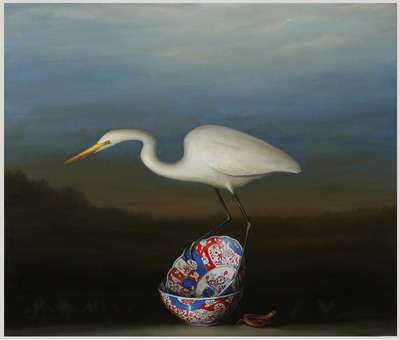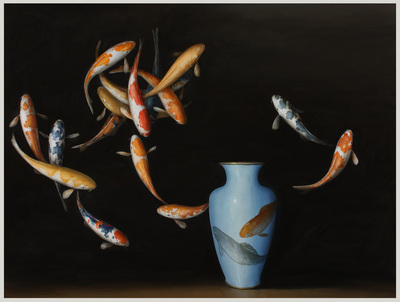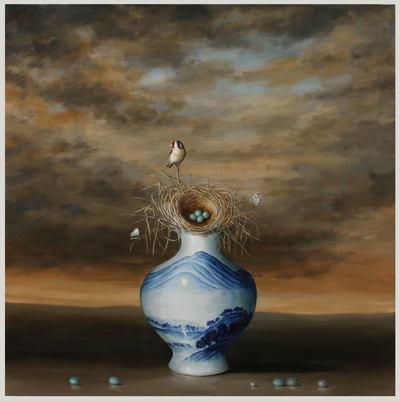DAVID KROLL
Artist Statement
I go to nature to be soothed and healed, and to have my senses put in order. -John Burroughs
Who says that all must vanish? Who knows, perhaps the flight of the bird you wound remains, and perhaps flowers survive caresses in us, in their ground. -Rainer Maria Rilke
My paintings explore the paradoxical relationship between human culture and the natural world. How do we deal with our strange duality as animal beings that are part of nature and rational beings that have separated from it? What does the concept of the "natural" world signify? What is our place in the natural world at this point in time? How do wild creatures exist in the ever-constricting world remaining to them in the wake of our haunting success?
We have touched and tended and tamed our world to such an extent that at times it seems that we have wrested the wild out of the wilderness. I believe we have done this as a species based on the mistaken notion that our survival depended on it. It is becoming ever clearer that the impulse that led us to tame, degrade and separate is resulting in increasingly precarious habitat for all living creatures - humans included. As the fragility of nature becomes more apparent, so does its value to us. My paintings explore nature not as an expendable resource but as a past home, once left and forgotten, now longed for and dreamlike.
I paint personal refuges, interior landscapes, moments - places to visit for solace and sanctuary, to be reminded of the value to the human spirit of wild creatures and wild places. Much of my work is intuitive. I do not approach my paintings as photographs or illustrations of real places or situations. It is not my intention to create an accurate depiction of a particular creature or habitat, but to create an invented, imaginary moment touching upon man's complicated, perplexing relationship with nature. I try to do more, in other words, than compose a visually interesting collection of wild creatures, objects and spaces. I try to create an emotional and intellectual connection - however fleeting - between the viewer and the power of landscape, the interdependent web of life, the idea of nature itself.
I am interested in beauty, not superficial prettiness. I try to paint substantial beauty. I approach my blank canvases without a definitive image and let the painting develop in a slow organic way. I paint in increasingly refined layers, a practice that allows me to discover the narrative and emotional content of each painting over time. Using this method, I try to express why a sunset fills me with wonder, why a certain quality of light can make a busy day suddenly still, and why the momentary sound of a bird call can seem - for that instant - like the most important thing in the world.
Ah, not to be cut off,
not through the slightest partition
shut out from the law of the stars.
The inner-what is it?
if not intensified sky,
hurled through with birds and deep
with the winds of homecoming.
-Rainer Maria Rilke
I wanna go out in the countryside
Oh sit by the clear, cool, crystal water
Get my spirit, way back to the feeling
Deep in my soul
-Van Morrison
Our lives have become increasingly removed from nature. Wilderness has been reduced to isolated refuges. As new development and building spread, there are fewer wild areas. Yet, each year people flock to these refuges, these parks, to admire and connect with nature. As we speed onward with progress, there is an intellectual and emotional longing for the natural world. Today is different from America in the 19th century. Civilization was moving west and progress represented promise. At that time there began a style of landscape painting sometimes referred to as "The Hudson River School". This was a peculiarly American style of landscape painting influenced by this country's large tracts of wilderness. Progress is documented in these paintings. Wilderness is depicted in the foreground of some of these works. As one's eye moves to the background, one witnesses stages of man's progress that culminates with a town or city. The artists expressed reverence for the landscape and sorrow about the vanishing wilderness. They lamented the loss of the native peoples and their lands. The devotional quality to many of these paintings suggests that nature and God were one.
I feel a link to America's early landscape painters. Whereas they document the progress of civilization with its attendant loss of the wild and unknown, I want to reclaim the wilderness. We can no longer experience unknown wild areas. We can visit designated wild areas, parks. We have become removed from nature, both physically and intellectually. Yet I believe a connection to nature is needed. It seems ingrained in our psyche.
I paint refuges, places to go to for solace. I want my paintings to be destinations of quiet and calm. However, this world is fragile. The elements in the foregrounds of my paintings are items carefully constructed, either by humans or animals. Yet, they are objects easily broken or destroyed. Birds represent messengers from the wild. They embody beauty and fragility. They are visitors that remind us of lands beyond, wilderness. The distant landscapes in my paintings are remembrances of the natural past, vaguely familiar and pleasing.
The natural world seems essential to me but I am puzzled by how one can integrate it into our urban lives. Although, we are neither able nor willing to return to an Arcadian state, we still need to have a relationship with nature. I want to add a sense of balance, order and beauty to a world that is weighted in the opposite.
The country where he lives is haunted by the ghost of an old forest. -Wendell Berry
The woodpecker -
still drilling
as the sun goes down.
-Kobayashi Issa
I paint personal refuges and interior landscapes - places to visit for solace and sanctuary. Much of my work is intuitive. My paintings are imagined, invented moments that touch upon human's complicated, perplexing relationship with nature. I try to create an emotional and intellectual connection - however fleeting - between the viewer and the power of landscape, the web of life, the idea of nature itself.
I think about the natural world not as an expendable resource but as a past home, once abandoned and forgotten, now the subject of our longing and our dreams. Increasingly what remains is an idea or memory of nature, rather than nature itself. This has been a central theme of my work for many years
My blank canvases are approached without a predefined image and the painting is developed in a slow, organic way. Painting in refined layers allows me to discover the narrative and emotional content of each composition over time. Using this method, I try to express why a sunset fills us with wonder, why a certain quality of light can make a busy day suddenly still, and why the momentary sound of a bird call can seem - for that instant - like the most important thing in the world.
Who says that all must vanish? Who knows, perhaps the flight of the bird you wound remains, and perhaps flowers survive caresses in us, in their ground. -Rainer Maria Rilke
My paintings explore the paradoxical relationship between human culture and the natural world. How do we deal with our strange duality as animal beings that are part of nature and rational beings that have separated from it? What does the concept of the "natural" world signify? What is our place in the natural world at this point in time? How do wild creatures exist in the ever-constricting world remaining to them in the wake of our haunting success?
We have touched and tended and tamed our world to such an extent that at times it seems that we have wrested the wild out of the wilderness. I believe we have done this as a species based on the mistaken notion that our survival depended on it. It is becoming ever clearer that the impulse that led us to tame, degrade and separate is resulting in increasingly precarious habitat for all living creatures - humans included. As the fragility of nature becomes more apparent, so does its value to us. My paintings explore nature not as an expendable resource but as a past home, once left and forgotten, now longed for and dreamlike.
I paint personal refuges, interior landscapes, moments - places to visit for solace and sanctuary, to be reminded of the value to the human spirit of wild creatures and wild places. Much of my work is intuitive. I do not approach my paintings as photographs or illustrations of real places or situations. It is not my intention to create an accurate depiction of a particular creature or habitat, but to create an invented, imaginary moment touching upon man's complicated, perplexing relationship with nature. I try to do more, in other words, than compose a visually interesting collection of wild creatures, objects and spaces. I try to create an emotional and intellectual connection - however fleeting - between the viewer and the power of landscape, the interdependent web of life, the idea of nature itself.
I am interested in beauty, not superficial prettiness. I try to paint substantial beauty. I approach my blank canvases without a definitive image and let the painting develop in a slow organic way. I paint in increasingly refined layers, a practice that allows me to discover the narrative and emotional content of each painting over time. Using this method, I try to express why a sunset fills me with wonder, why a certain quality of light can make a busy day suddenly still, and why the momentary sound of a bird call can seem - for that instant - like the most important thing in the world.
Ah, not to be cut off,
not through the slightest partition
shut out from the law of the stars.
The inner-what is it?
if not intensified sky,
hurled through with birds and deep
with the winds of homecoming.
-Rainer Maria Rilke
I wanna go out in the countryside
Oh sit by the clear, cool, crystal water
Get my spirit, way back to the feeling
Deep in my soul
-Van Morrison
Our lives have become increasingly removed from nature. Wilderness has been reduced to isolated refuges. As new development and building spread, there are fewer wild areas. Yet, each year people flock to these refuges, these parks, to admire and connect with nature. As we speed onward with progress, there is an intellectual and emotional longing for the natural world. Today is different from America in the 19th century. Civilization was moving west and progress represented promise. At that time there began a style of landscape painting sometimes referred to as "The Hudson River School". This was a peculiarly American style of landscape painting influenced by this country's large tracts of wilderness. Progress is documented in these paintings. Wilderness is depicted in the foreground of some of these works. As one's eye moves to the background, one witnesses stages of man's progress that culminates with a town or city. The artists expressed reverence for the landscape and sorrow about the vanishing wilderness. They lamented the loss of the native peoples and their lands. The devotional quality to many of these paintings suggests that nature and God were one.
I feel a link to America's early landscape painters. Whereas they document the progress of civilization with its attendant loss of the wild and unknown, I want to reclaim the wilderness. We can no longer experience unknown wild areas. We can visit designated wild areas, parks. We have become removed from nature, both physically and intellectually. Yet I believe a connection to nature is needed. It seems ingrained in our psyche.
I paint refuges, places to go to for solace. I want my paintings to be destinations of quiet and calm. However, this world is fragile. The elements in the foregrounds of my paintings are items carefully constructed, either by humans or animals. Yet, they are objects easily broken or destroyed. Birds represent messengers from the wild. They embody beauty and fragility. They are visitors that remind us of lands beyond, wilderness. The distant landscapes in my paintings are remembrances of the natural past, vaguely familiar and pleasing.
The natural world seems essential to me but I am puzzled by how one can integrate it into our urban lives. Although, we are neither able nor willing to return to an Arcadian state, we still need to have a relationship with nature. I want to add a sense of balance, order and beauty to a world that is weighted in the opposite.
The country where he lives is haunted by the ghost of an old forest. -Wendell Berry
The woodpecker -
still drilling
as the sun goes down.
-Kobayashi Issa
I paint personal refuges and interior landscapes - places to visit for solace and sanctuary. Much of my work is intuitive. My paintings are imagined, invented moments that touch upon human's complicated, perplexing relationship with nature. I try to create an emotional and intellectual connection - however fleeting - between the viewer and the power of landscape, the web of life, the idea of nature itself.
I think about the natural world not as an expendable resource but as a past home, once abandoned and forgotten, now the subject of our longing and our dreams. Increasingly what remains is an idea or memory of nature, rather than nature itself. This has been a central theme of my work for many years
My blank canvases are approached without a predefined image and the painting is developed in a slow, organic way. Painting in refined layers allows me to discover the narrative and emotional content of each composition over time. Using this method, I try to express why a sunset fills us with wonder, why a certain quality of light can make a busy day suddenly still, and why the momentary sound of a bird call can seem - for that instant - like the most important thing in the world.




